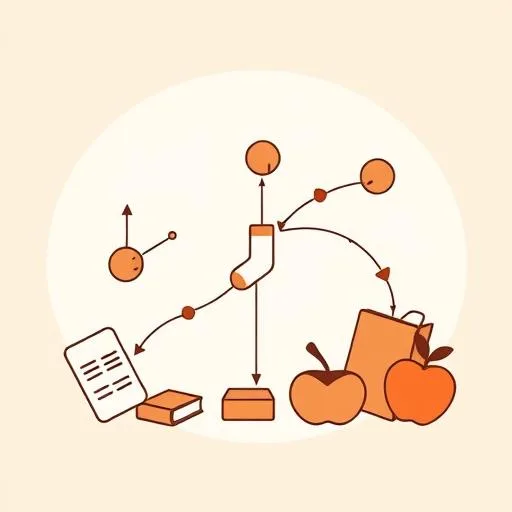
Walking my daughter to school this morning, the early autumn air was crisp and the sky was just dazzlingly clear. The faint scent of roasted chestnuts from a street vendor made me smile. That’s when a lightbulb moment struck me—and it’s been buzzing in my head all day. I’d been reading about how companies are using brilliant new architectures to build intelligent supply chains, and I realized… WOW. We’re not just parents; we’re the chief operating officers of the most important, chaotic, and wonderful logistics network in the world: our family.
How Can Supply Chain Thinking Transform Family Life?

Stick with me here! It sounds technical, but it’s SO real. Every single day, we manage an incredible flow of goods. We’re talking about snacks, clean socks, bedtime stories, emotional support, and endless reserves of patience. Our little customers—our fantastic kids—have demands that change in real-time. And the disruptions? Oh, the disruptions are constant! A sudden fever, a forgotten homework assignment, a mysterious Lego piece that’s gone missing right before bedtime—it’s a daily adventure!
For years, many of us have tried to manage this with traditional systems: rigid schedules, strict rules, the classic “this is how we do things” approach. But just like in the world of global logistics, those old models can’t keep up. They’re brittle. They snap under pressure. The news about needing a “new operating architecture” for supply chains isn’t just for big business; it’s a mind-blowing insight for parenting! It’s not about more automation (which in parent-speak might mean just plopping a kid in front of a screen). It’s about building something smarter, more flexible, and deeply human—a system built for connection, not just control.
What Does a Resilient Family Look Like in Practice?

So, what does this new system look like? The magic words from all this supply chain talk are adaptability and resilience. And isn’t that EVERYTHING we want for our kids and our families? A resilient family doesn’t mean a family where nothing ever goes wrong. It means a family that can absorb a shock—a bad day, a tough week, a spilled glass of juice that feels like the end of the world—and bounce back, maybe even stronger.
Research shows that smart systems build resilience by detecting risks and finding patterns. For us parents, this is our superpower! It’s that gut feeling you get. It’s noticing your child is a little quieter than usual after school and choosing a cozy board game over a chaotic trip to the playground. It’s seeing the pattern that late-night screen time leads to grumpy mornings and adjusting the flow. It’s what IBM notes about AI-powered supply chains: the ability to find patterns and relationships to keep things in balance. We can be the warm, loving, human version of that—the heart of our family’s resilient operating system.
Just last week, I noticed my daughter was quieter than usual after school, so we skipped our usual playground trip and stayed home for puzzles and storytelling instead. Sometimes the best thing you can do is pause, listen, and gently adjust the rhythm of the day.
How Can You Apply Supply Chain Strategies to Parenting?

This isn’t about turning our homes into factories. HECK NO! It’s about borrowing some brilliant concepts to create more harmony and joy. Let’s break it down into a simple, powerful playbook:
- Forecasting Needs: Just like a smart system predicts demand, we can anticipate our family’s needs. After a week packed with school, playdates, and activities, you can forecast that your little one’s emotional battery will be low. So, you plan for a restorative, low-key Saturday morning with pancakes and puzzles. It’s proactive love in action!
- Real-Time Visibility: A supply chain needs to know where everything is, right now. For us, that’s about checking in emotionally. It’s the simple, “How was your heart today?” at the dinner table. It’s being present enough to see the little signs and respond with empathy in the moment, not hours later.
- Awesome Communication: The best systems are built on seamless communication. This is our family huddle! It’s the quick chat in the morning about the day ahead. It’s the bedtime debrief. It’s creating a home where everyone feels safe to share their “inventory” of feelings, knowing they’ll be handled with care. This is how we build a family that truly works together.
How Does Resilient Parenting Lead to Thriving Families?

Let’s be clear: the ultimate goal here is not perfect efficiency. It’s creating a family that really flows. It’s building a foundation so strong, so adaptable, and so full of trust that it actually creates more space for spontaneity, laughter, and pure, unadulterated joy. When you’re not constantly putting out fires because your system is too rigid, you have the energy to build a magnificent bonfire of happy memories instead!
At our house, dinner isn’t just about eating—it’s where we share stories, make plans, and sometimes debate whether kimchi tastes better with rice or tucked inside an omelette. Those little moments blend tradition with today’s realities, just like balancing tech time with real-world play.
The articles talk about supply chains evolving into “intelligent ecosystems.” What an absolutely BEAUTIFUL metaphor for a family! An ecosystem is alive, interconnected, and collaborative. It adapts and grows. By thinking this way, we’re not just managing the day-to-day; we’re nurturing a living, breathing system of love. We’re raising kids who are not just prepared for life’s disruptions but are masters of adaptability, champions of resilience, and experts in bouncing back with a smile. And that, my friends, is a logistics win that’s worth celebrating. What a thought to hold onto.
What kind of resilient ecosystem will your family become as you continue to grow and adapt together?
Source: Webinar: Building the Intelligent Supply Chain – Practical Lessons from AI Architectures in Action, Logistics Viewpoints, 2025/09/05
